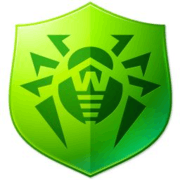Dr. Web
 | |
| Initial release | 1992 |
|---|---|
| Stable release |
11.0
|
| Development status | Active |
| Operating system |
Linux Mac OS X Microsoft Windows DOS OS/2 Windows Mobile Android BlackBerry |
| Available in | Russian, English, French, German, Japanese, Korean |
| Type | Antivirus |
| Website |
www |
Dr.Web is a Russian anti-malware company and the name of its flagship software suite. First released in 1992, it became the first anti-virus service in Russia.[1]
The company also offers anti-spam solutions and is used by Yandex, Russia's biggest search provider, to scan e-mail attachments. There is also an add-on for all major browsers which checks links with the online version of Dr Web.[2]
Dr.Web has withdrawn from AV tests such as Virus Bulletin VB100% around 2008 stating that they no longer represent the ability to counteract contemporary malware threats.[3]
Notable discoveries
Flashback Trojan
Dr.Web discovered the Trojan BackDoor.Flashback variant that affected more than 600,000 Macs.[4]
Trojan.Skimer.18
Dr.Web discovered the Trojan.Skimer.18, a Trojan that works like an ATM software skimmer.[5] The Trojan can intercept and transmit bank card information processed by ATMs as well as data stored on the card and its PIN code.
Linux.Encoder.1
Dr.Web discovered the ransomware Linux.Encoder.1 that affected more than 2,000 Linux users.[6] Linux.Encoder.2 which was discovered later turned out to be an earlier version of this ransomware.
Trojan.Skimer discovery and attacks on Doctor Web offices
The day that Doctor Web published a news item about Trojan.Skimer.18 getting recorded in the company’s virus database (December 18, 2013), Doctor Web received a threat supposedly from the Trojan writers or criminal organization sponsoring this malware’s development and promotion:[7] On March 31, after two arson attacks were carried out on Igor Daniloff’s anti-virus laboratory in St. Petersburg,[8] company received a second threat. Doctor Web released a statement that the company considers it its duty to provide users with the ultimate protection against the encroachments of cybercriminals and consequently, efforts aimed at identifying and studying ATM threats are in progress as is work to improve Dr.Web ATM Shield.[9]
See also
References
- ↑ "Dr. Web LTD Doctor Web / Dr. Web Reviews, Best AntiVirus Software Reviews, Review Centre". Reviewcentre.com. Retrieved 2014-02-17.
- ↑ Web, Doctor (2013-10-07). "Dr. Web LinkChecker :: Add-ons for Firefox". Addons.mozilla.org. Retrieved 2014-02-17.
- ↑ "Doctor Web: statement on Virus Bulletin comparative reviews". news.drweb.com. Retrieved 2015-11-03.
- ↑ Greenberg, Andy (April 9, 2012). "Apple Snubs Firm That Discovered Mac Botnet, Tries To Cut Off Its Server Monitoring Infections". Forbes. Retrieved April 10, 2012.
- ↑ "Trojan.Skimer.18 infects ATMs". news.drweb.com. Retrieved 2015-11-27.
- ↑ Dr.Web (November 6, 2015). "Encryption Ransomware Threatens Linux Users". Forbes. Retrieved November 16, 2015.
- ↑ "Dr.Web - ATM Trojans – Doctor Web and ATM Trojans". antifraud.drweb.com. Retrieved 2015-12-09.
- ↑ "ATM Skimmer Gang Firebombed Antivirus Firm — Krebs on Security". krebsonsecurity.com. Retrieved 2015-12-09.
- ↑ ""На карте – ваши деньги"! Банкоматные троянцы угрожают вам, а их распространители – поджогами и физической расправой сотрудникам компании "Доктор Веб"". news.drweb.ru. Retrieved 2015-12-09.
External links
- Official website (English)